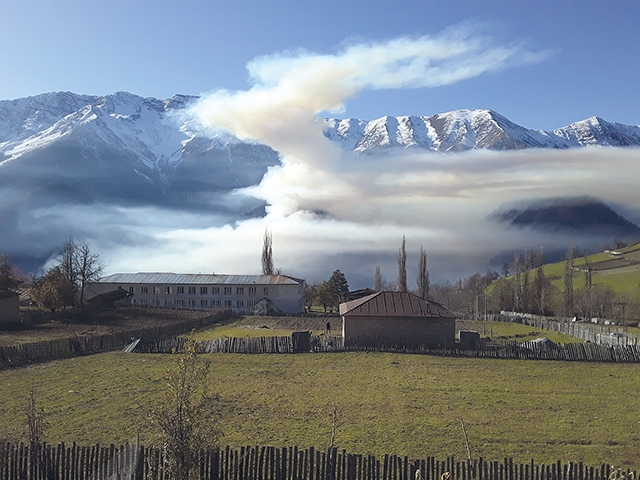Hot off the Press: Etseri, Svaneti
Blog
Looking out the windows facing south at about 9 this morning (Nov. 18), it was clear that the weather was unusual. There were clouds, but these were both not forecast and the wrong color, too yellow. Smoke!
We’d been having dry weather for weeks, otherwise a boon to farmers in this late fall season, but the leaves had all fallen and crisped right up. Something across the Enguri River from us could have triggered a flame: the sun’s rays catching on a bit of clear plastic or glass and focusing to a hot point, perhaps. The wind was minimal, which would stop the mass from choking us by moving north, but it was certainly spreading east and west as well as rising. No one lived there on that side of the river, but further east is the village of Tskhumari, right in the smoke’s path.
I began taking photos, single shots and three-frame panoramas, on my cell phone; my big camera’s experiencing trouble and currently not usable, but these images at least captured what was unfolding not far away. It might have started with just leaves, but trees too were now burning at midday.
A neighbor told me he’d called 112 (emergency services in Georgia) and “brigades will be sent”, but when? I continued documenting the spread. If it did engulf us in smoke (though the fire has little to feed on in our fields now), would the air get bad enough to force us to leave?
Having seen recent news of huge fires in Brazil and parts of the USA, one could hardly compare this: far fewer people live in Svaneti, for example. But also a much smaller proportion of them have cars if evacuation would be called for; and I would expect the firefighting personnel to struggle more, given what equipment could be available to work with and the difficult access by anything other than air. There’s just the one road through Svaneti, from Zugdidi up through Mestia and Ushguli, then down again through Lentekhi to Kutaisi. Lots of things to consider when it’s suddenly in your area, visibly growing!
WE can evacuate ourselves: what about the livestock, though? Cows (only a few giving milk this late in the year), horses, sheep, goats, pigs, poultry. What happens to them? Turned loose to fend for themselves? They could all actually survive on what nature has if we left them to it; but they’d scatter if abandoned long enough. Uninsured, of course.
As I write this mid-afternoon, a new cloud, thicker and more yellow, occasionally rises up from the spread-out strata of thinner, wind-borne cloud in the original location. There is now thick smoke in bands over about 160 degrees of the landscape. Still no news of anything being done about it. The airspeed where we are is still minimal, but simple displacement is gradually pushing a thinned-out part towards us, slowly degrading visibility. I’ll admit, though, that here what we can see we can’t smell. Someone responds to my Facebook posts in Mestia, 28 km above us, however, that they can smell the smoke: just local people burning leaves or corn stalks, or really this forest fire? Time to call 112 again?
The drama unfolds before my eyes. What I can’t see from here, though, is either flame or actual location of the burning. It’s all obscured by the sheer amount of smoke.
Evening falls, the sun disappearing over the southern mountain wall before 5 pm as we move towards the year’s shortest day in a month and a bit. We can now see the actual fire glowing by its own light as tonight’s full darkness descends, despite the smoke continuing to veil it so thickly. It’ll likely burn all night. But my cell phone can’t even come close to capturing images in the dim light, to which my eyes need several minutes to adjust. So all I can do is describe them. Tomorrow will bring new sights.
It’s the 19th now, and media have been reporting on the fires here and elsewhere and on efforts to fight them on difficult terrain. The smoke remains, but it’s not being carried across to us much; its smell is still not detectable, so our air quality at least here is not much worse. Small mercies! I would guess that, judging by the difference between yesterday’s smoke and today’s, the fires had not been burning long when we woke up to them yesterday. The smoke clouds then had much sharper edges, not having been diffused much by wind, whereas today the spread is much wider.
This evening, as the sun sets at 4:30 pm, the opposite mountain wall is the clearest it’s been for three days, only lightly veiled by smoke now. A single plume rises, lighter against the trees; a good sign that things are winding down. Night’s cold will help too, we hope.
Morning of the 20th: now just a light haze, the worst (here) is over, with some local people having joined the firefighters. Snow forecast for tomorrow, which can also only help.
I can only imagine what people go through who have actually to flee a forest fire or heavy smoke from it. This is only a light taste of what could be possible. At least much of our main road out of here is not through forest, and is on high, wide, rocky river banks which a fire would be unlikely to jump across. We still hope it all dies out soon, though, with not too much more loss to the beautiful, vital forests of Svaneti and beyond.
Tony Hanmer has lived in Georgia since 1999, in Svaneti since 2007, and been a weekly writer for GT since early 2011. He runs the “Svaneti Renaissance” Facebook group, now with nearly 2000 members, at www.facebook.com/groups/SvanetiRenaissance/
He and his wife also run their own guest house in Etseri:
www.facebook.com/hanmer.house.svaneti
By Tony Hanmer












